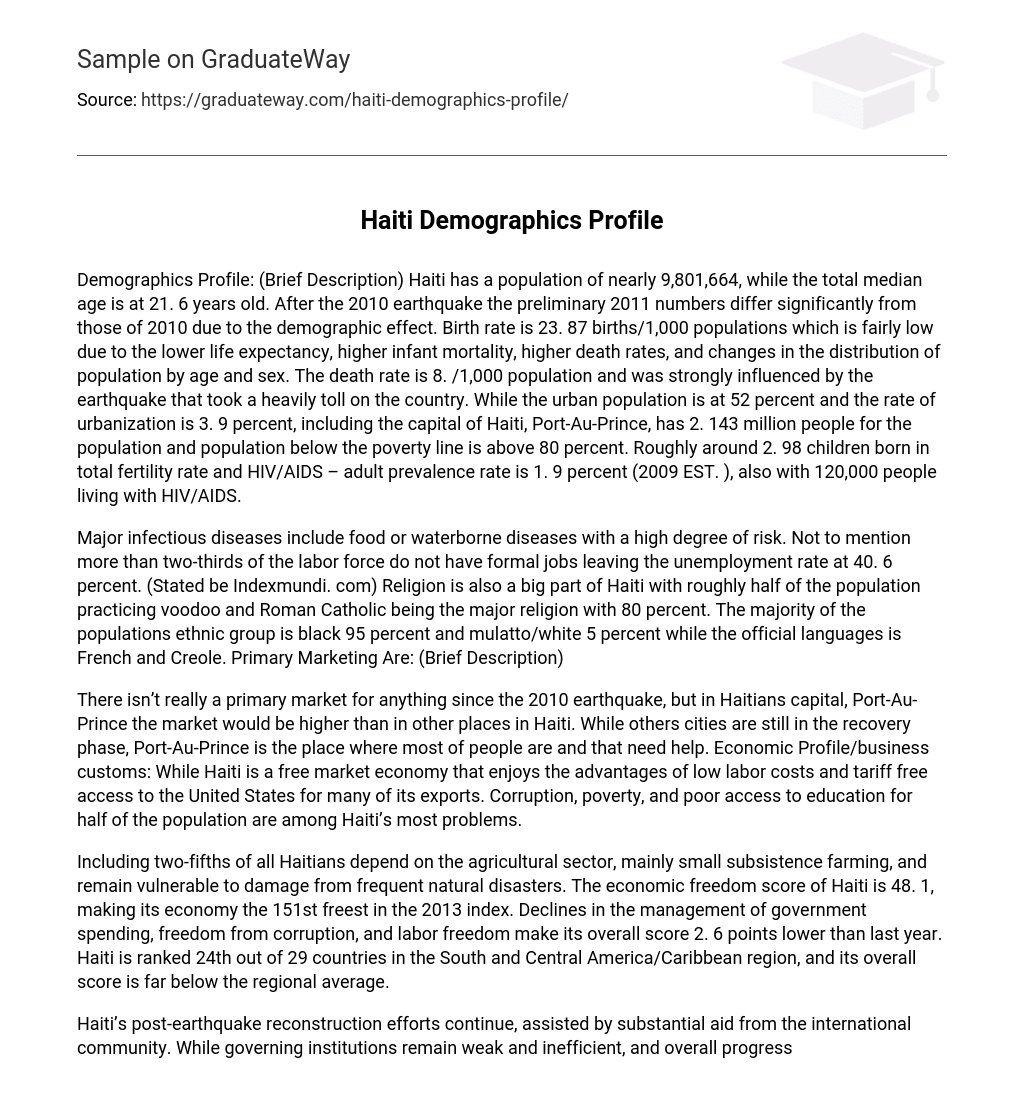Haiti has a population of nearly 9,801,664, while the total median age is at 21. 6 years old. After the 2010 earthquake the preliminary 2011 numbers differ significantly from those of 2010 due to the demographic effect. Birth rate is 23. 87 births/1,000 populations which is fairly low due to the lower life expectancy, higher infant mortality, higher death rates, and changes in the distribution of population by age and sex.
The death rate is 8. /1,000 population and was strongly influenced by the earthquake that took a heavily toll on the country. While the urban population is at 52 percent and the rate of urbanization is 3. 9 percent, including the capital of Haiti, Port-Au-Prince, has 2. 143 million people for the population and population below the poverty line is above 80 percent. Roughly around 2. 98 children born in total fertility rate and HIV/AIDS – adult prevalence rate is 1. 9 percent (2009 EST. ), also with 120,000 people living with HIV/AIDS.
Major infectious diseases include food or waterborne diseases with a high degree of risk. Not to mention more than two-thirds of the labor force do not have formal jobs leaving the unemployment rate at 40. 6 percent. (Stated be Indexmundi. com) Religion is also a big part of Haiti with roughly half of the population practicing voodoo and Roman Catholic being the major religion with 80 percent. The majority of the populations ethnic group is black 95 percent and mulatto/white 5 percent while the official languages is French and Creole. Primary Marketing Are: (Brief Description)
There isn’t really a primary market for anything since the 2010 earthquake, but in Haitians capital, Port-Au-Prince the market would be higher than in other places in Haiti. While others cities are still in the recovery phase, Port-Au-Prince is the place where most of people are and that need help. Economic Profile/business customs: While Haiti is a free market economy that enjoys the advantages of low labor costs and tariff free access to the United States for many of its exports. Corruption, poverty, and poor access to education for half of the population are among Haiti’s most problems.
Including two-fifths of all Haitians depend on the agricultural sector, mainly small subsistence farming, and remain vulnerable to damage from frequent natural disasters. The economic freedom score of Haiti is 48. 1, making its economy the 151st freest in the 2013 index. Declines in the management of government spending, freedom from corruption, and labor freedom make its overall score 2. 6 points lower than last year. Haiti is ranked 24th out of 29 countries in the South and Central America/Caribbean region, and its overall score is far below the regional average.
Haiti’s post-earthquake reconstruction efforts continue, assisted by substantial aid from the international community. While governing institutions remain weak and inefficient, and overall progress has not been substantial. The parliament has not renewed the mandate of the Interim Haiti Recovery Commission, which had been tasked with overseeing reconstruction efforts, but was unpopular. The effectiveness of public spending has been severely undermined by ongoing political volatility that undercuts the already weak foundations of the rule of law.
Reforms to improve the business and investment climates have had little effect because of pervasive corruption and the inefficient judicial framework. According to the Investing across Borders indicators, foreign investment in Haiti is subject to a general ownership restriction across all business sectors as stipulated in the country’s Commercial Code. Any locally incorporated company, regardless of the business sector in which it is active, must have at least three shareholders, one of whom must be a Haitian national.
Haitian law further stipulates that any foreign investment with a potential impact on the country’s economy is subject to presidential approval, regardless of the business activity concerned. Including to those general restriction, the country imposes sector-specific limits on foreign equity ownership in 2 of the 33 sectors covered by the Investing across Sector indicators.
Source
- The Heritage Foundation Index of Economic Freedom, http://www. heritage. org/index





